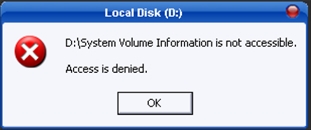
folder System Volume Information , exists on any partition of a HDD which has installed as an operating system, Windows . Whether it is a partition NTFS or Fat32 . It's a Folder protected by the system, in which data are collected about the files in the respective partition, restore points/backup. With the default settings of windows, this folder is hidden (hidden on the hdd partition) and access the the east restricted.
To see this folder and have access to it, some settings are needed… depending on the type of Windows installed and the format of the partition.
Microsoft Windows XP Professional or Windows XP Home Edition pe FAT32 File System
1. Click pe Start , then click on My Computer
2. In the menu Tools, click pe Folder Option
3. On the button View , click to check Show hidden files and folders.
4. Uncheck the option: Hide protected operating system files (Recommended) and click on Yes to confirm the changes.
5. Click OK
6. Double click on the folder System Volume Information .
7. That's it. Simple, right?
To access the System Volume Information folder, on NTFS (Windows XP Professional) a unui FIELD, the procedure changes a little.
1. Click pe Start , then click on My Computer
2. In the menu Tools, click pe Folder Option
3. On the button View , click to check Show hidden files and folders.
4. Uncheck the option: Hide protected operating system files (Recommended) and click on Yes to confirm the changes.
5. Click OK
Up to this point, the procedure is identical, as with FAT32, only that when you try to access the folder, a restriction will appear. “Access is Denied.“

6. Click-right on the folder System Volume Information and click on Properties.
7. Click Add, and in the opened window, enter the name of the user to allow access to the folder. As a rule, the name of the user who is logged in at that moment. Click OK & OK.
8. Double-click on the si folder … pleasant entertainment.
Note: In the same way, System Volume Information, can be accessed by users who use Windows XP Home Edition.
For Windows XP Home Edition / NTFS, the command can also be used CACLS (it is executed from cmd.exe) .
The problem is the following. I have the strength to search and write the syntaxes of CACLs now. Please come back! :)
System Volume Information
What’s New
About Stealth
Passionate about technology, I write with pleasure on stealthsetts.com starting with 2006. I have a rich experience in operating systems: Macos, Windows and Linux, but also in programming languages and blogging platforms (WordPress) and for online stores (WooCommerce, Magento, Presashop).
View all posts by StealthYou may also be interested in...


One thought on “System Volume Information”